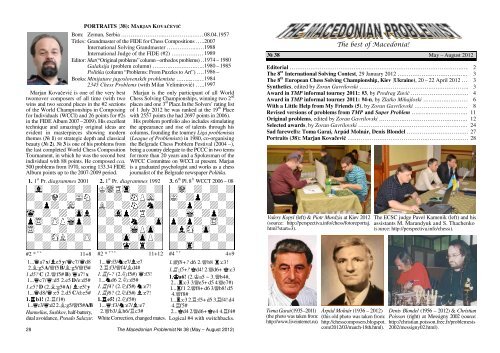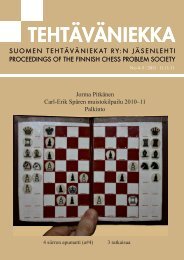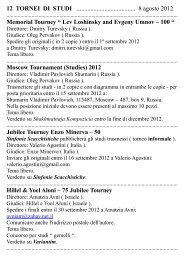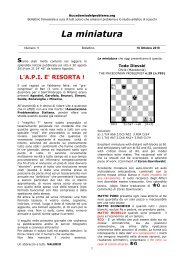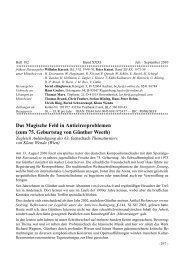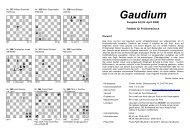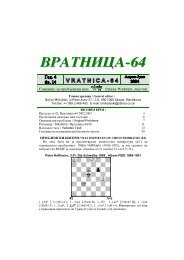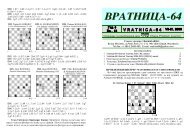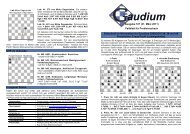PORTRAITS (38): MARJAN KOVAĆEVIĆ Born - Accademia del ...
PORTRAITS (38): MARJAN KOVAĆEVIĆ Born - Accademia del ...
PORTRAITS (38): MARJAN KOVAĆEVIĆ Born - Accademia del ...
You also want an ePaper? Increase the reach of your titles
YUMPU automatically turns print PDFs into web optimized ePapers that Google loves.
The best of Macedonia!Editor:Zoran GavrilovskiP. fah 137, Skopje MK - 1001, MacedoniaE-mail: mprobl@yahoo.comRegular collaborators:Zivko Janevski, Predrag Zuvić, Stephen Emmerson,Petko A. Petkov, Hans Gruber, Zlatko Mihajloski, Nikola StolevProof-reading: Predrag ZuvićLanguage control (except pp. 3-5): Stephen EmmersonAnnual subscription fee: 12 € for Macedonia (+3 € for foreign mail expenses)Proof-reading: Predrag ŽuvićLanguage control: Christopher ReevesAnnual subscription fee: 12 € for Macedonia (+3 € for foreign mail expenses)Dear chess problem friendsAt the beginning of autumn we have thehonour of presenting the second 2012 issueof The Macedonian Problemist (TMP).It starts by presenting brief reports on theInternational Solving Contest 2012 and theEuropean Chess Solving Championship 2012and with a new issue of the “Synthetics”column (p. 3).Two awards in our informal tourneys for2011 are published at pages 4 – 5 and 6 – 7,respectively. The promptness of our judges isundeniably good and we also hope that thesame could be said about their selection ofhonoured problems and the reasons providedin the respective awards.The quantity of originals in this issue (pp.12 – 23) is satisfactory, but the quality canbe further improved, thus contributors arecordially invited to send their best for “thebest of Macedonia”. In such a way we hope tomaintain the high non-formal rating of TMPand LMP measured by the total of 21 problemsselected for the FIDE Album 2001 – 2003.E D I T O R I A LOur regular column “Selected awards” (pp.24 – 26) brings to the attention of our readerssome tourney awards featuring problems byMacedonian composers. These awards indicatethat the size of the country has nothing to dowith the rating of its chess composers on theinternational scene.In the column “Sad farewells” (p. 27) wepay tribute to three deceased problemists:Toma Garai (USA), Árpád Molnár (Hungary)and Denis Blon<strong>del</strong> (France). While helpmatescomposed by Garai and Molnár have providedvaluable contributions to the art on 64 squares,Blon<strong>del</strong> indebted the chess problem world bypreparing and producing (jointly with BerndEllinghoven) six excellent FIDE Albums whichset high standards for future issues of thisanthology.This issue ends with the best of the worldin the #2 field. We are very glad to present toour readers the double winner of the WCCI inthe #2 section, whose innovative output andexcellent composing technique continue toprovoke admiration worldwide.2 The Macedonian Problemist № <strong>38</strong> (May – August 2012)SAD FAREWELLS:TOMA GARAI (1935 – 2011), ÁRPÁD MOLNÁR (1936 – 2012), DENIS BLONDEL (1956 – 2012)With great sorrow we bring news of the recent death of three distinguished problemistsand pay tribute to them and their achievements in the field of problem chess.Toma Garai (17.5.1935 – 30.1.2011) was a Romanian problemist who had started hiscomposing career in 1951 with orthodox problems (#2, #3) and after emigrating to the USA(1970) switched almost exclusively to helpmates. He has published more than 2,100 problemsand the booklet Chess Problems of the Same Kind (1994). Toma Garai viewed problem chess asfun, but he was seriously successful with his composing successes, including the acquisition ofthe titles of FIDE Grandmaster for Chess Compositions (1996) and International Judge for ChessCompositions (1987) and a score of 94 FIDE Album points up to the 2007 – 2009 period. Hishelpmates demonstrated thematic clarity, elegance and/or complexity, often showing strategicelements such as capture of white pieces, battery play, pin mates (№ I), line opening/closing, etc.Árpád Molnár (18.03.1936 – 24.03.2012) was a Hungarian International Master for ChessComposition from 2008 (29 FIDE Album points up to the 2007 – 2009 FIDE Album), whose 51-year long composing opus included around 450 problems (mainly helpmates). His highly thematicand excellently constructed helpmates in two moves often combined intensive strategy withwealth of play, such as the fivefold cyclic Zilahi in a Meredith setting which won 2 nd Pr. In theOlympic tourney 1982 (Ka6, Tf8, Lb8, Ld5, Sb4, Sb6 (6), ke7, tb5, tf5, la4, la7, pc5 (6),1.t:b4 Sc4 2.ld7 Ld6#, 1.l:b8 Tf7+ 2.kd6 Sc4#, 1.l:b6 Te8+ 2.kd7 Lc6#, 1.t:d5S4d5+ 2.ke6 Tf6#, 1.t:f8 Lf7 2.kd8 Sc6#), the double Zilahi from TMP 2001 (№ II), afivefold Island theme presentation with a single black line (1 st Pr. G. Páros – 80 JT 1992) etc.Denis Blon<strong>del</strong> (11.1.1956 – 21.6.2012) was a French problemist, editor and publisher of theFrench problem chess magazine Phénix and of six FIDE Albums (in cooperation with BerndEllinghoven) covering the period from 1986 to 2003. He and Bernd were jointly involved inpreparing and publishing a series of prominent chess problem books, such as those containingselected problems by Jacques Savournin (1992), Hans Peter Rehm (1994), Robin Matthews (1995),Shlomo Seider (1996), Norman Macleod (1997), György Páros (2003), John Rice (2003), etc.He held the title of International Judge for Chess Compositions since 1989 and scored 7.5 FIDEAlbum points with jointly composed fairies. № III entered the FIDE Album’s Annex 1986 – 1988(a transmuting king, when in check, takes the power(s) of the checking unit(s) in place of its own).I. Toma Garai3 rd Pr. Mat. 1987II. Árpád MolnárSp. Pr. The Maced. Problem. 2001III. D. Blon<strong>del</strong> & M. Caillaud2 nd – 3 rd Pr. J. Zeller – 75 JT 1986H#2 2 solutions 6+12 H#2 4 solutions 6+13 #2 Transmuting kings 12+71.d:f5 S:e4+ 2.k:e4 Th4#1.t:f5 S:d5+ 2.k:d5 Lg8#This h#2 scored 10.5 points inthe FIDE Album 1986 – 1988.1.tf3 Ta6 2.b:a6 Sc6#1.f3 S:f4 2.e:f4 Te7#1.sg1 T:g7 2.l:g7 S:g5#1.lb1 S:d4 2.k:d4 T:a4#1.Sg6! (2.Se7#)1...kc6/k:d6/ke6/kc4/g42.a8L/d:e8D/f8S/c8T/Sf4#4-flights giving key and AUW.The Macedonian Problemist № <strong>38</strong> (May – August 2012) 27
ORBIT 2009 / H#2-IIInformal tourney - 55 problems, 4 Prizes, 8 Hon. Mentions, 5 Commend. Judge: Aleksandr Semenenko1 st 5 th Pr. Fadil AbdurahmanovićPr. Valery Gurov& Zivko Janevski5 th Comm. Ivan DenkovskiH#2 2 solutions 10+13 H#2 5 solutions 6+11 H#2 b) Kf5↔kc8 6+141.d:e4 Tb7 2.sf7 Lc6#1.d:f7 Db7 2.se4 Ld7#“Destruction of black batteries,white battery creation & play,Zilahi and Umnov. A memorableproblem.” (Judge)1.dc3 Te2+ 2.kd4 Dd1#1.kf5 Tf2+ 2.df4 Db1#1.kd6 Kb5 2.dd5 Le5#1.kf6 T:g2 2.de5 Df1#1.d5 Df1 2.td6 Te2#Five pin mates.a) 1.sd7+ Te5 2.c5 Te8#b) 1.s:f6+ Te8 2.lg8 Te5#The T first self-pins itself andmates after being unpinned.Reciprocal white moves andsquare vacation.STRATEGEMS 2010 / H#3Informal tourney - 34 problems, 5 Prizes, 4 Hon. Mentions, 5 Commendations. Judge: Jorge Kapros1 st Pr. Ricardo de Mattos Vieira 1 st H.M. Petre Stojoski 4 th H.M. Petre StojoskiH#3 b) kc4→e3 5+12 H#2.5 2 solutions 6+14 H#3 2 solutions 5+7a) 1.d4 Le4 2.dd5 S:d53.tfg5 Sd6#b) 1.e:f4 Lf3 2.te5 S:e53.dc7 Sf5#“Remarkable strategy for adirect unpinning problem.”(Judge)Sacrifices at B2 and <strong>del</strong>ayedUmnov mates.1...L:b3 2.g4 Lf6+3.kd5 d:e4#1...Lb5 2.g2 L:f2+3.k:d3 Sb4#“It was not easy to determinethe sequence of moves tothis <strong>del</strong>ightful Zilahi, withpin mates ...” (Judge)… by means of line opening.1.d:b3 T:g5 2.db1 Tg13.la2 Lf6#1.d:a3 L:g5 2.db2 Lf63.ta2 Tg1#“I like very much that in thissimple idea and setting bothsides have the same strategy.”(Judge)Black & white line clearances.26 The Macedonian Problemist № <strong>38</strong> (May – August 2012)THE 8 TH INTERNATIONAL SOLVING CONTES, 29 JANUARY 2012The 8 th International Solving Contest (ISC) in 2012 consisted of 32 tourneys, which wereheld simultaneously in 27 countries on 29 January 2012. Once again Alex Steinbrink acted asa Central controller, coordinating the work of local controllers. 328 solvers from 33 countriesparticipated and they were ranked in two categories: 220 participants in the category ofexperienced solvers and 108 in the category of less experienced solvers.The winner of the first category (and overall winner) was Eddy Van Beers with 54 pointsout of maximal 60, ahead of 2. Volodymir Pogorelov (53.5), 3. Piotr Murdzia (53), 4. JonathanMestel (52.5), 5. Bojan Vučković (51.5), 6. Kacper Piorun (49), 7. Valery Kopyl (48.5), 8. BorisTummes (48), 9. Anatoly Mukoseev (47.5), 10. Aleksandr Azhusin (46.5), 11. Thomas Maeder(44.5), 12. Andrey Petrov (44), 13.Milan Velimirović (43.5), 14. Ram Soffer (43), 15. HansUitenbroek (42), 16. Ofer Comay (41.5), 17. Peter van der Heuvel (41), 18. Johan de Boer (41),19. Aleksandr Bulavka (41), 20. Dinu-Ioan Nicula (40.5) etc.The results are available at: http://www.saunalahti.fi/~stniekat/pccc/isc12_1.htm (if youwish to try solving yourself the 12 problems from the 8 th ISC, you can find them at:http://www.saunalahti.fi/~stniekat/pccc/solving.htm).THE 8 TH EUROPEAN CHESS SOLVING CHAMPIONSHIPKiev (Ukraine), 20 – 22 April 2012 (judge: Pavel Kamenik)Pl. TEAM Points Time Pl. Solver Country Points Time1. SERBIA 190.25 1046 1. Piotr Murdzia Poland 70.75 3332. POLAND 189.25 1050 2. Vladimir Podinić Serbia 70.50 3363. RUSSIA 177.50 1074 3. Bojan Vučković Serbia 65.00 3564. UKRAINE 1 176.25 1066 4. Georgy Evseev Russia 64.50 3605. AZERBAIJAN 168.00 1061 5. Kacper Piorun Poland 62.25 3606. LITHUANIA 154.00 1076 6. Misratdin Iskandarov Azerbaijan 62.00 3547. GREAT BRITAIN 148.75 1077 7. Klemen Šivic Slovenia 59.60 3598. FINLAND 148.50 1067 8. Volodymir Pogorelov Ukraine 58.00 3579. SLOVAKIA 143.50 1077 9. Marko Filipović Croatia 57.50 34810. UKRAINE 2 141.75 1077 10. Martynas Limontas Lithuania 57.50 36011. BELARUS 134.75 1064 11. Oleksiy Solovchuk Ukraine 56.75 36012. SLOVENIA 120.50 1079 12. Marek Kolčák Slovakia 55.75 35913. ROMANIA 113.50 1075 13. Piotr Górski Poland 55.00 36014. ISRAEL 83.25 1080 14. Aleksandr Bulavka Belarus 54.75 346Open solving tourney Kiev 20121. Valery Kopyl (44.5 pts of 60 possible),2. P. Murdzia (42), 3. A. Bulavka (40.5)15. Harri Hurme Finland 54.75 35116. Araz Almammadov Azerbaijan 54.75 35317. Marjan Kovačević Serbia 54.75 354SYNTHETICSby Zoran GavrilovskiP. fah 137, Skopje MK-1001, Macedonia(e-mail: mprobl@yahoo.com)Synthetic <strong>38</strong>: h#3, 2 solutions, 1.kc4 L:b2 2.lc3 La1 3.kd4 T:b4#, 1.kc3 T:b4 2.tc4Ta4 3.kd4 L:b2#. The position of no. <strong>38</strong> should be sent to the editor until 28.2.2013.The Macedonian Problemist № <strong>38</strong> (May – August 2012) 3
THE MACEDONIAN PROBLEMIST INFORMAL TOURNEY 2011: MATE IN THREE MOVESAWARD by Predrag ZuvićA total of 18 threemovers were published in 2011 (№s 1042 – 1047 in TMP no. 34, №s 1090 –1092 in TMP №. 35 and №s 1132 – 1140 in TMP № 36). Their quality varied from barely averageproblems with trivial content to very good and interesting works. I selected the following problems:1 st Prize: № 1137vZoran Gavrilovski2 nd Prize: № 1139Arieh Grinblat1 st Hon. Mention: № 1136Zivko JanevskiSREDBA NA SOLIDARNOSTA 2012 / studies, formal ty, 43 studies, 6 Pr., 5 HM, 4 Cs. Judge: Iuri Akobia1 st Spec. Comm. Boško MilošeskiPr. Andrzej Jasik Spec. H.M. Zlatko Mihajloski& Zlatko Mihajloski#3* 15+9 #3 13+11 #3 12+101...kd4 2.D:b4+ ke5 3.f4# 1.T:g5! (2.Dh4+ se4 3.D:e4#) 1.e3! (2.Dd4+ A kd6 3.Se4# B)1...k:d6 2.L:c7+ A kc5 1...t:d5 2.Se5+ A t:e5 3.Dd3# 1...kd6 2.Se4+ B d:e4 3.Dd4# A3.Se6# B1...l:c3 2.Sb2+ B l:b2 3.Dd3# 1...g:h5 2.Sb3+ C kd6 3.Df4#1.S:b4! (2.Sd3+ kb~ 3.Dc5#; 1...sf3 2.De4+ sd4 3.Se5# A 1...d4 2.De5+ dd5+ 3.Sb3# C2.Sd5+?/Sc2+? lb4!)1...th8 2.D:g7 (3.Sb2# B)1...kd4 2.Sd5+ ke5 3.f4#1...dg7 2.D:e6 (3.Dc6/Sb3#)[2.Sd3+?/Sc2+ lb4!/ke5!]2...l:c3 3.D:c3#2...dc3 3.Dc6#1...k:d6 2.Sc2+ ke5 3.L:c7#1...d:d8 2.D:e6 (3.Dc6/Sb3#)[2.Sd3+?/Sd5+? lb4!]2...dd7 3.Sb3#1...kb6 2.L:c7+ A kc53.Se6# B1...l:b4 2.Se6+ B kb63.L:c7# A1 st Prize: № 1137v, Zoran GavrilovskiThe author timely submitted two versions of problem № 1137 (extending and completingthe content shown in TMP № 36), of which I considered the more economical one. After aS/D battery formation by the key which also grants a flight square, k-defences on the d-filepin the l and determine the exact choice of activation of the white battery (in order to avoidunpin of the l– effect of Schiffmann defences), with cyclic dual avoidance in these variationsand the threat. Jumps by the S at W2 are also changed continuations in relation to the setplay. The non-thematic defence 1...kb6 transfers the white play from the variation 1...k:d6in the set play (Ruchlis). Finally, both non-thematic variations (after 1...kb6 and 1...l:b4)show exchange of second and third moves of White.2 nd Prize: № 1139, Arieh GrinblatExcellent combination of the B theme (Somov B2) and the Keller paradox after Blackdefends by capturing Ps. S-sacrifices at W2 release the squre d3 for the white queen. Inthe second pair of variations the same moves by the S are mates, thereby creating a strongand logical connection with the first two variations.4 The Macedonian Problemist № <strong>38</strong> (May – August 2012)+ 6+5 = 2+7 = 5+41.Sc6+ ka8 2.Tb6 ld4+3.Tb2! l:b2+ 4.Ka2![4.K:b2? t:b3+? 5.T:b3 th2+6.Kb1 th1+ =] 4...ta4+!5.b:a4 ta3+ 6.Kb1! [thematictry 6.K:b2? t:a4, mutualzugzwang with White tomove, draw] 6...ta1+ 7.Kc2![7.K:b2? t:a4 zz =], 7...t:a48.K:b2 mutual zz with Blackto move, 8...s:c5 9.Tb8#1.Kc7 ka7 2.Kc6+ ka6 3.Te8ka5 4.-6.Kc5-c4-c3 ka4-a3-a27Ḳc2 se3+ 8.T:e3 h2 9.Te7ka3 10.Kc3 ka4 11.Kc4 ka512.Kc5 ka6 13.Te6+ kb714.T:h6 g3 15.T:h7+ kc816.-19.Kc(d-e-f)6 kd(e-f-g)820.-22.Th(g-h)3 g2-kh8-g823.Tg3+ kf8 24.Ta3 ke825.Ke6 kd8 26.Kd6 kc827.Kc6 kb8 28.Tb3+ =1.b6+ k:b6 2.a7! [2.h7? a2 3.Kc4t:e5 4.h8D a1d 5.Dg7+ kb66.Df6+ ka5 7.Dd8+ ka4 -+]2...k:a7 3.h7! a2 4.Kc4! t:e55.h8D a1d 6.Dg7+ kb6[6...kb8 7.Dh8+ kc7 8.Dg7+8...kd8 9.Dh8+ ke7 10.Dg7+10...ke6 11.Dg6+ posit. draw]7.Df6+ ka5 8.Dd8+ ka49.Dd1+ d:d1=A version of authors’ study (1984).SREDBA NA SOLIDARNOSTA 2012 / S#2-5, formal ty, 16 problems, 2 Pr., 2 HM, 2 C. Judge: Zivko Janevski1 st Pr. Andrey Selivanov 2 nd Pr. Zoran Gavrilovski 1 st H.M. Eugene FomichevS#3 13+8 S#3 v v v 12+11 S#3 11+91.Lh2! (zugzwang)1...b:a6/l~/ld4/le52.Sa7+/Sbc7+/Sc3+/Sac7+2...kd4/kd4/kc6/l:c73.Sc6+/Se6+/Lf3+/L:c73...d:c6/d:e6/d5/d6#Nikoletić theme (Pickaninny #s).1.La6?/Lc8?/Lc6? (2.d4+)1...kb6!/kd6!/s:f6!1.La8! (d4+ kb6/kd63.Tb7+/Td7+ t:b7/t:d7#)1..ḳb6 2.Dd4+ ka5 3Ṭa7+ t:a7#1..ḳb6 2.Sb7+ ke6 3Ṭe7+ t:e7#1...s:f6 2Ṭ:f6 b1d 3.Sd7+ t:d7#1.Dh7! (2.Kg6+! ke43.Lf5+ l:f5#)1...t:d7 2.Th4+ df4+3.Ke6+! tg7#1...l:d7 2.Ke7+! d:h83.Th4+ lg4#Good white royal battery play.The Macedonian Problemist № <strong>38</strong> (May – August 2012) 25
SELECTED AWARDS by Zoran GavrilovskiBELGRADE INTERNET TY. 2012 / #2, formal ty., 14 problems, 4 Pr., 5 HMs, 3 Cs. Judge: M. Kovačević1 st Pr. Miodrag Mladenović 3 rd Pr. Zoran Gavrilovski 2 nd H.M. Zivko Janevski1 st Honourable Mention: № 1136, Zivko JanevskiFour pin mates, of which one in the threat and three after black thematic defences. In thethreat and the variation after the king’s flight there is exchange of second and third movesof White. It would have been splendid if such a reciprocity was achieved in the second pairof variations (after defences by black pawns), given the fact that the white move Sb3+ isalready transferred from W2 after 1...g:h5 to W3 in the variation after the defence 1...d4.2 nd Hon. Mention: № 1045Zivko Janevski1 st Commendation: № 1135Arieh Grinblat2 nd Commendation: № 1134Leonid Makaronez#2 * v v v 11+9 #2 * v v v v v v 11+10 #2 * v v 8+81...c :d6 2.f :e4#1...k:f5 2.Lg6# A1...e:f5 2.D:d5# [2.Dd4? ke6!1.Sa6? (2.D:c5#) k:c6! 1.Lg6? A (2.f6# B) tg8! 2.D:f5? k:f5!] ; 1.Dd2? k:f5!1...c:d6 2.Sb4# [2.f:e4? k:c6!] 1. f6? B (2.Lg6# A) t:e8! 1.Tf1? (2.Dd4#) sf2!1.e :d4? (2.D:c5#) d:d4! 1.Tc6? (2.Sd6# C) td8! 1...e:f5 2.D:f5# [2.D:d5? k:d5!,1...c:d6 2.c4# [2.f:e4? t:e4!] 1.Td7?! (2.Sd6# C) k:f5! 2.Dd4? ke6!]1.Se6? (2.D:c5#) e:f3! 1.Lf6? (2.Dg4/Df3# D/E) g4! 1...lf3 2.Tc5#1...c:d6 2.Sf4# [2.f:e4? k:e4!] 1.Sd7? (2.Dg4# D) d2! 1.Sf4! (2.Sg6#)1.b4! (2.D:c5#)1...k:f5 /g4 2.Df3# E/ Sf6# 1...e:f5 2.Dd4 [2Ḍ:d5? k:f4!,1...c:d6 2.Da2# [2.f:e4? kc4!] 1.T:d5! (2.E#) k:f5/g4/l:d5/k:d5 2.D:f5? k:f5!]Theme described on page 8. 2.Dg4 D / T:d4/Sd6 C/Lc6# 1...le4/k:f4 2.Tc5/Tc4#SREDBA NA SOLIDARNOSTA 2012 /#3, formal ty, 20 problems, 2 Pr., 2 HMs, 2 Cs. Judge: Zoran Gavrilovski1 st Pr. Arieh Grinblat, EvgenyBourd & Aleksandr Feoktistov 2 nd H.M. Zlatko Mihajloski 1 st Comm. Zivko Janevski#3 v v 12+8 #3 * v v v v 7+3 #3 * 8+91.f3? lf2!, 1.Lb4? sd6! 1...ke5/kc5 2.Dd5/Db4# 1...kd5 2.Da5+ ke4/kc41.Ld1! (2.Dd5+ ld4/sd4/td4 1.Sf4? / 1.Df7? / 1.K~? / 1.Dc8? 3.De5/Db5#3.Sc5/Tf3/Sb4# A/B/C) 1...ke5!/kc5!/ke6!/ke7! 1.Sb5! (2.Dd4+ k:f5 3.De5#)1...ld4 2.Sb4+ C t:b4 3.Dc2# 1.Lc6! (zz) ke5/kc5/ke6 1...sc6 2.Sfd6+ kd5 3.Sc7#1...sd4 2.Sc5+ A l:c5 3.De4# 2. De7+/Dc7/Dd7+ 1...se6 2.Sbd6+ kd5 3.Se7#1...td4 2.Tf3+ B se3 3.T:e3# 2...kf5(kd4)/kd4/ke5 1...kd5 2.Dd4+ kc6/ke61...se3 2.f:e3 ~ 3.Sf2/Le2# 3.Le4(Dd6)/Dd6/Dd5# 3.Sa7/Sg7# [1..ḳ:f5 2.De3]24 The Macedonian Problemist № <strong>38</strong> (May – August 2012)#3 11+7 #3 10+9 #3 8+111.Tb6! (2.Tb5+ k:c6 3.Tc5#) 1.g:f5! (2.Le4 ~ 3.T:d3#) 1.Tff7! (2.Ld4+ kg5 3.Se4#)1...ld4 2.c4+ kc5 3.Te5# 1...lb6 2.Te4+ A kc5 1...e5 2.L:h4+ ke6 3.Tf6#1...le5 2.Sc7+ ke4 3.Tb4# 3.Sb3# B1...se5 2.e4+ kf4 3.Lg5#2...k:d6 3.Td7#1...lb8 2.Sb3+ B kc4 1...c6 2.Le7+ ke5 3.Ld6#1...se6 2.Df3+ ke5 3.Tb5#3.Te4# A1...l:g7 2.L:g7+ kg5 3.Se4#1...d2 2.Tc3 (3.Te4/Sb3#)2...d1d/l 3.Te4# A2...e:f5 2.Sb3# B1...e:f5 2.Td5+ ke43.Td:d3/Sd2#2 nd Honourable Mention: № 1045, Zivko JanevskiThe author has written a book on anticipatory self-pin (ASP) in helpmates long timeago, exploring the theme (as noted in the editor’s comment) in a large number of problems.Here the ASP with three pin mates is shown in an orthodox threemover with very goodconstruction (only the modest role of the white queen can be criticised).1 st Commendation: № 1135, Arieh GrinblatExchanged second and third moves of White after defences by the black bishop. Thesemoves appear as mating threats after a defence by the d-pawn and a quite move by thewhite rook. The dual mate after the non-thematic defence 1...e:f5 is not a particular flaw.2 nd Commendation: № 1134, Leonid MakaronezFive different moves by the white bishop as a front battery piece (including the threat afterthe key) in variations with varied effects. Four batteries (of which one – after the defence 1...c6– is a Siers battery) are activated at the second move. Only after the defence by the black knightdoes White give a battery mate and it is a pity that it was not possible to avoid double check.I thank the editor for entrusting me to judge the tourney and submitting the necessary data.Predrag Zuvić, Zagreb, 15 August 2012The Macedonian Problemist № <strong>38</strong> (May – August 2012) 5
THE MACEDONIAN PROBLEMIST INFORMAL TOURNEY 2011: MATE IN 4 AND MORE MOVESAWARD by Zlatko Mihajloski36 problems of a satisfactory quality participated in the tourney under the followingnumbers: 1048, 1049, 1050, 1093, 1094, 1095, 1096, 1097, 1098, 1099, 1100, 1101, 1141,1142, 1143, 1144, 1145 and 1146.My award is as follows:Prize: № 1095Leonid Makaronez1 st Hon. Mention: № 1146Ralf Krätschmer2 nd Hon. Mention: № 1143Arieh Grinblat#4 9+10 #7 v 6+13 #4 9+111.Lf1! (2.Sf7+ k:e6 3.Lc4+3...ld5 4.L:d5#)1...t:a5 2.Lh3 A ld53.Dc7+ B kf6 4.S:h7# C3...kd4 4.Sf5#1...ld5 2.Dc7+ B kf63.S:h7+ C k:e6 4.Lh3# A1...td6 2.Dh8+ kd5 3.c4+3...kc6 4.Dc8#1...tc6 2.Sh:f3+ kf5 3.Df8+3...kg6 4.Ld3#1.Te4+? k:e4 2.Te6+ l:e6!1.Sc6+! kf5 2.La6! ld73.Lc8! l:c8 4.Tb4!4...la6 5.Se7+ ke56.Te4+ k:e4 7.Te6#4...b2 5.Tb5+ dd56.T:d5+ ke4 7.Te5#1.g6! (zugzwang)1...tb1/tb2 2.Te5+ A f:e53.Sg5+ C k:d4 4.Se6+4...ke4 5.Sg3# B1...lg4 2.Sg3+ B k:f43.Se2+ ke4 4.Sg5+ C4...f:g5 5.Te5# A1...lg2/lf1 2.Sg3+ k:f43.T:f5+ kg4 4.Sh2+4...kh3/kh4 5.Th5#Prize: № 1095, Leonid MakaronezThe most complete problem in the tournament.Excellent co-operation of thewhite pieces in all variations. The mobility of the white queen leaves a particularlygood impression.1 st Honourable Mention: № 1146, Ralf KrätschmerA logical problem with impressive play by the white bishop 2.La6 and 3.Lc8!, whichensured the high ranking.2 nd Honourable Mention: № 1143, Arieh GrinblatA waiter after a weak key move, but the beautiful play in the variations eliminates thisflaw.6 The Macedonian Problemist № <strong>38</strong> (May – August 2012)1267. H. Gockel1.L:d7-d6? (2.Lf4# A) d:c4-c5!1...b:c4-c5 2.D:a4-f4# B1...f5 2.D:h8-d4# C1.Df7! (2.D:d5-d4# C)1...b:c4-c5 2.L:a4-f4# A1...f5 2.D:f5-f4# B1...d:c4-c5 2.Da2#1...d4 2.Se4#Take & Make: having captured,a unit must immediately, asa part of its move, play a noncapturingmove in imitationof the captured unit fromthe capture square.Shedey cycle. It was indeednecessary to invest somematerial to prevent the cook1.D:d7→d6?! (2.D:d5→d4/Df4/Se4#) s:c6→d7+!,while the dh5 is neededto prevent 1.D:g6→g8?!df7/dg6/dh7! (Author)1268. V. Agostini1.k:e2-h5 Te5 2.g4 Th1#1.d5 Lg4 2.k:e1-e6 Ta6#Pin mo<strong>del</strong> mates. (Z.G.)1269. S. Dietricha) 1.lh5 Sf7 2.t:f3 S:g53.te3+ Kf4 4.th3 Sf3#b) 1.tf6 f4 2.lh4 S:g43.te6+ Kf5 4.th6 Sf6#Bureaucratic chess: a unitmay move or capture onlyif observed by an enemyunit. When the conditionapplies only to a pawn, it ispreserved when it promotes.Castling is possible only ifthe king is observed by anenemy unit (no check inthis case).Miniature with echo mates.Disappearance of the blackbishop. (Author)1270. V. Agostini &G. Brunoria) 1.Kf5 tg8 2.Ld8 dc83.Le7+ d6#b) 1.Kg7 tb7 2.Le4 de83.Tc6+ d:c6#Helpselfmate: Black helpsuntil his final move, whichmust be forced, as in a s#.1271. Z. Mihajloski1...td4 2.Sb8 [Da7?] td83.Da7 ta3 4.Le4+ l:e4#1...te5 2.Sa7 [Da7?] ta53.Lb7 th8+ 4.Sf8+ t:f8#Double pin mates. (Author)After 1...td4 only 2.Sb8[Da7?] (anti-dual situation),not 2.Sa7 [Da7?], as the Dis used for something elseand the S must evacuateanyway. (Maryan Kerhuel)1272. M. Grushko1.S f:e5=L [+pf7] s:e5=l[+Lc6] 2.S :e5=L [+ld7]2...f6 3.L :d7=T [+lc6]3...f:e5=s [+Lf6] 4.L:e5=T[+sf6] se8=p 5.T :e8=D[+pe5] [+kb8] l:d7=t[+Tc6] [+Kd8] #Einstein: A piece playing anon-capturing move changesinto another piece in the sequenceQ-R-B-S-P-P; whena capturing move is playedthe sequence is P-S-B-R-Q-Q.Platzwechsel Circe: capturesare as in Circe, but the capturedpiece is reborn on the departuresquare of the capturing unit.Republican Chess: the sidewhich has played a move putsthe opposite king on a squarewhere he would be legallymated and then the oppositeside can put the other king ona square where he is mated.1273. V. Agostini1.o:e5 Te8 2.w:e4 T:e3#1.w:e5 Lg7 2.o:d4 Tc3#Kamikaze piece: a piece (nota king) making a capture isremoved from the board togetherwith the captured piece.Annihilation of Ps. (Z.G.)1274. G. Prahl1.tb8 Ff3 A 2.tb4 Fd3 B3.td4 Fc3 C 4.f e5 Fc2# D1.kd4 Fc3 C 2.ke4 Fc2 D3.td8 Fhf3 A 4.td4 Fd3# BCirce: when captured, a piece(other than king) is reborn onits game-array square (if thatsquare is occupied, the capturedpiece disappears).Grasshopper: moves along Q-lines over a unit of either colourto the square immediately beyondthat unit. A capture may be madeon arrival, but the hurdle is notaffected.Anti-battery mate and cycleof white moves. (M.K.)1275. V. Kotešovec1.kd5 Ka2 2.fe4 Kb33.kc6 Kc4 4.fb4 Fb55.kb7 Fb3 6.fb8 Kb57.ka8 Ka6 8.sf7 Fg8+9.sd8 Fc8#1.kd3 Ka2 2.kc2 Ka33.fa2 Fd2 4.kb1 Kb35.ka1 Kc2 6.sf7 Kc17.sd6 Fd7 8.sb7 Fa7+9.sa5 Fa4#1.ff3 Kb1 2.fd5 Kc23.kf3 Kd3 4.fd2 Fe25.kg2 Fc2 6.fh2 Ke27.kh1 Kf1 8.sg6 Fh7+9.sh4 Fh3#Triple echo. (Author)The original problems whichare published in this issue arecomputer tested. (Z.G.)The Macedonian Problemist № <strong>38</strong> (May – August 2012) 23
1267. Hubert GockelMetzingen (Germany)RETROS AND FAIRIES / JUDGE: HANS GRUBER (GERMANY)1268. Valerio AgostiniPerugia (Italy)1269. Stephan DietrichHeilbronn (Germany)3 rd Hon. Mention: № 1050Oto Mihalčo4 trh Hon. Mention: № 1048Zoran Gavrilovski1 st Commendation: № 1101Mirko Degenkolbe#2 v Take & Make 12+15 H#2 Take & Make2 solutions1270. Valerio Agostini& Gabriele BrunoriPerugia (Italy)HS#3 b) La5→h71273. Valerio AgostiniPerugia (Italy)1271. Zlatko MihajloskiSkopje (Macedonia)6+6 HS#3.5 2 solutions1274. Gerd PrahlLeingarten (Germany)5+7 H#4 Bureaucratic chessb) kh4→h53+41272. Mikhael GrushkoKiryat-Byalik (Israel)9+9 HS#5 Einstein, PWCRepublican Chess2+21275. Vaclav KotešovecPrague (Czech Republic)H#2 2 solutions 8+5 H#4 Circe 2 sols. 5+5 H#9 3 solutions 2+3w, o = kamikaze pieces f , F = grasshoppers f , F = grasshoppers22 The Macedonian Problemist № <strong>38</strong> (May – August 2012)#10 7+8 #4 9+7 #7 2+51.L:a6! kd4 2.Sc2+ kd53.Ke3 e5 4.Lc8 c4 5.Ld7 c56.Sa3 c3 7.Sb5 (8.Se:c3+8...kc4 9.Le6+ kb4 10.a3#)7...kc4 8.Le6+ kb4 9.a3+9...k:a4 10.Se:c3#1...c4? 2.Ke3 c3/kd5 3.Sc41...kd5? 2.Ke3 ... #61.Se5! (2.S:f3+ t:f3 3.S~#)1...g1d 2.Sg5+ kg23.Dh3+ kf2 4.Se4#1...g1s 2.Sf2+2...kg2 3.D:h1+ k:g3/k:f24.Se4/Dh2#2...sh3 3.D:h3+ kg14.T:f1#1.Da1! g5 2.Ke5 g43.Kf4 g3 4.Da8! (5.Kg3)4...l~! 5.K:g3 lf2+6.Kh3 ~ 7.D:g2#4...lf2 5.Kg4 kg16.Da1+ le1 7.D:e1#3 rd Honourable Mention: № 1050, Oto MihalčoA good key move, giving a flight to the black king, good co-operation of white piecesand mo<strong>del</strong> mate.4 th Honourable Mention: № 1048, Zoran GavrilovskiGood determination of promotions to s and d, but with a short threat.1 st Commendation: № 1101, Mirko DegenkolbeA minimal miniature, where the goal is accomplished with manoeuvres by the whitequeen and approach by the white king.2 nd Commendation: № 1082Gerd Prahl1.Lc2? A (2.Sc7 kc4 3.Kd6 kb4 4.Kd5 ka5 5.Lc3#) k:b5!1...kc42.Sc7 B kc5 3.Ke5 kc4 4.Kd6 kb4 5.Kd5 ka56.Lc3#1.Sc7! B (2.Sa6#)1...kb4 2.Lc2 A kc5 3.Ke5 kc4 4.Kd6 kb4 5.Kd5 ka56.Lc3#A miniature giving a flight to the black king and with interestingtry and solution.#6 v 5+2 July 2012International judge of FIDE Zlatko MihajloskiThe Macedonian Problemist № <strong>38</strong> (May – August 2012) 7
WITH A LITTLE HELP FROM MY FRIENDS (5)by Zoran GavrilovskiThe fifth issue of this column starts with a trio of #2s, of which the first two positions showthe theme of the Belgrade Internet Tourney (BIT) 2012: a mate after defence 1...a in the set playis refuted in various ways in two or more phases and there is change of mate in each phase after1...a, i.e. 1...a 2.A#, 1.X! 1...a 2.B# [2.A? 1...p!], 1.Y? 1...a 2.C# [2.A? 1...r!] (please see theselection of three problems from that tourney at page 24 in this issue). At the time of my work forthe BIT (May 2012), our German collaborator has already published his Zagoruiko 3 x 2(diagrammed as № A1 below), in which the set mates are avoided in a try and solution by theneed to re-pin a black piece that was unpinned by the first move in each phase. However, onlyafter finishing the position of № A2, it occurred to me that I might have seen such doubling ofthe BIT 2012 theme in the same matrix and soon after I remembered that it has been composedby Rainer Paslack. He acknowledged that saving four units and adding by-play by the unpinnedblack pieces is an improvement, but also suggested that the problem lacks originality to bepublished as original (either joint or with the label “after Paslack”). Therefore this versionbecame ineligible for the BIT 2012 and for the TMP 2012 informal tourney, too.My efforts to add a touch of originality in an acceptably well constructed position becamepossible after shifting the set play to the thematic try 1.S:e3? (with mates by the Sf6 – 1...da5 x2.Sd7# A, 1...sc2 y 2.Se4# B), similarly refuted as the try 1.Se5? (by a black bishop’sobstruction of the white queen’s access to b4). The added value of № A3 is in the additionalchange of mate after 1...sd4 (2.D:d4# in the tries and 2.De5# in the solution) and in theA1. Rainer Paslack7 th Pr. FIDE World Cup 2011#2 *v11+12 #2 *v1...da1 2.Se6#1...se2 2.Sf3#1.Se5? (2.c3#) e:d2!1...da1 2.Sc6# [2Ṣe6+? t:e6!]1...se2 2.Sef3# [2Ṣgf3+? t:f3!]1...t:d5 2.T:d5#1.Sf4! (2.c3#)1...da1 2.Sfe6# [2Ṣge6+? l:e6!]1...se2 2.S:e2# [2Ṣf3+? l:f3!]1...e:d2/t:d5 2.D:f2/T:d5#A2. Version of № A1by Zoran Gavrilovski1...t:a4 2.Sd6#1...db1 2.Se3#1.Se4? (2.T3b4#) db2!1...t:a4 2Ṣed6# [2Ṣfd6+? l:d6!]1...db1 2.Sd2# [2Ṣe3+? l:e3!]1...ld6+/d:c3 2.Se:d6/T:c3#1.Sd5! (2.T3b4#)1...t:a4 2.Sb6# [2Ṣd6+? t:d6!]1...db1 2.Sde3# [2Ṣfe3+? t:e3!]1...t:e2/d:c3 2.D:e2/T:c3#A3. R. Paslack & Z. GavrilovskiOriginal, after R. Paslack10+9 #2 v v 9+161.S:e3? (2.Db4#) l:f4!1...da5 2.Sd7#1...sc2 2.Se4#1.Se5? (2.Db4#) le4!1...da5 2Ṣed7# [2Ṣfd7+? kd~!]1...sc2 2.Sd3# [2Ṣe4+? f:e4!]1...sd4 2.D:d4#1.Sd6! (2.Db4#)1...da5 2Ṣb7# [2Ṣd7+? t:d7!]1...sc2 2Ṣde4# [2Ṣfe4+? kd~!]1...sd4 2Ḍe5# (1...le4 2.Sd:e4#)1258. N. Popaa) 1...Sh6 2.le6 Sf73.lc7 Lb5#b) 1...Se7 2.tc7 Ke53.le8 Td4#The Grimshaw at c7 isnot pure, because the twomoves to c7 are self-blocksas well. (P.Z.)However, two mo<strong>del</strong>mates and good economyare perhaps sufficient tojustify the publication ofthis lightweight. (Z.G.)1259. C. Jonsson1.kd3 Sb7 2.tc82...Kd5 3.tc3 Sc1#1.lg2 Sf7 2.kf32...Kf5 3.tf2 Sd4#Unusual self-pinning playby the S allows the K tostep onto the fifth rank,and this S moves nomore, while the other Sgives mo<strong>del</strong> mates. (Z.G.)1260. A. Onkoud &C. Jonsson1.s:b6 L:h3 2.kd52...Kd2 3.ke4 Lg2#1.l:g2 S:a8 2.kd52...Kc2 3.kc4 Sb6#The 7 th WCCT theme isshown with the same typeof effect (mutual capture)in the play of two pairs ofpieces of opposite colours.(M.B.)Zilahi with reciprocal bicolourcaptures of twopairs of pieces of the sametype and switchback mo<strong>del</strong>mates. (P.Z.)1261. C. Jonsson1.ta4 La1! [Lb2?]2.kb4 Lb2 3.sc5 Sc6#1.le3 La5! [Lb4+?]2.k:d4 Lb4 3.td5 Sf3#Excellent combination ofwaiting moves by the whitebishop, black self-blocks (ofwhich those at B1 are distant)and nice mo<strong>del</strong> mates. A wellconstructed Meredith withvery attractive content. (Z.G.)1262. V. Nefyodov1.tc2 T:d4 A 2.k:d4 Td1+3.kc3 S:d5# B1.tc5 S:d5 B 2.k:d5 Tf43.kc4 Td:d4# ABlack and white squarevacation, exchange of moveswith exchange of squares ofsacrifice and mate, Zilahitheme and mo<strong>del</strong> mates. Fullanalogy between the solutions.The black king is mated ondifferent squares. (Author)Excellent strategic problemwith matching solutions. Iwonder whether this matrixallows a possibility of showingboth cyclic Zilahi and cyclicsquare vacation?! (Z.G.)1263. Z. Labaia) 1.sf7+ Td4 2.ke7 Se53.se6 Sg6#b) 1.kd6 Sh6 2.sc6+ Te53.ld7 Sf7#Simple building of matingnets with self-blocks andchecks to the K. (Z.G.)Umnov effects at W2, ofwhich 2...Se5 is <strong>del</strong>ayed.(M.B.)1264. C. Jonesa) 1.td4 e:d4 2.lg3 [kf4?]2...Te5+3.kf4 e3#b) 1.lf4 e:f4 2.td6 [kd5?]2...Tc4+ 3.kd5 e4#Sacrifices by black pieces atB1 bring the white bishop intoplay, while anti-critical playdetermines the order of blackmoves. The orthogonal-diagonaltransformation of the play andthe mo<strong>del</strong> mates should not bemissed either. (Z.G.)1265. F. Abdurahmanović &Z. Mihajloski1...La7 2.tc4 [tc3?] Tb63.t:d4 e:f5 4.td3 Te6#1...Te8 2.ld5 [lc4?] Le73.l:e4 d5 4.ld3 Lc5#Full harmony and pure mates.(Authors)Reciprocal battery creationby White and opening of adiagonal or orthogonal whiteline by a black annihilationcapture of Pd4 or Pe4. (Z.G.)There is dual avoidance onlyafter 1...La7 2.tc4 [td6?],but not in the other solution.This is a pity. (M.B.)1266. Z. Mihajloski1.dh2! L:d6! 2.le5! Lf8![Lc5?] 3.lf6 Lh6 4.dd6!4...Kf2 5.ke5 Ke3 6.de66...Lf4#Bristol by the white bishop,the black bishop and the blackqueen and round-trip by thewhite bishop. (Author)Some long distance movesand good geometry. (Z.G.)8 The Macedonian Problemist № <strong>38</strong> (May – August 2012)The Macedonian Problemist № <strong>38</strong> (May - August 2012) 21
1258. Nicolae PopaArsura-Vaslui (Romania)H#3-N / JUDGE: MILOMIR BABIĆ (SERBIA)1259. Christer JonssonSkarholmen (Sweden)1260. Ab<strong>del</strong>aziz Onkoud &Christer JonssonStains/Skarholmen (Fra./Swe.)H#2.5 b) Lc4=Tc4 4+6 H#3 2 solutions 3+7 H#3 2 solutions 4+61261. Christer JonssonSkarholmen (Sweden)1262. Vladislav NefyodovChelyabinsk (Russia)1263. Zoltan LabaiVeĺký Kýr (Slovakia)exchanged motifs of refuting the mates by the Sf6 in the other try and the solution – 1.Se5?,1...x 2.C# [2.A? k-flight!], 1...y 2.D# [2.B? capture by the unpinned piece!], 1.Sd6!,1...x 2.E# [2.A? capture by the unpinned piece!], 1...y 2.F# [2.B? k-flight!]. By movingthe white bishop from f1 to e6 (and removing the pe6 from the chessboard) 2.A/B# wouldbe set play mates and the k B2-refutations to the same mates in the try and the solutionwould be determined exclusively due to white line interference at W1 – 1.Se5? (f4-d6interfered with), 1... x 2.A? kd6!, 1.Sd6! (d6-d4 interfered with), 1... y 2.B? kd4! Still, insuch a way the construction would be less successful as the Sf6 would only <strong>del</strong>iver mates inthe set play (absorbed by 1.S:e3? (=1.Sc4~?) as the only random move with a dual-freeplay at W2) and would be idle in the post-key play of the other phases. Turning back to theanalysis of the diagrammed position, the ”random” move to e3 is determined by the need togain control over d5 and the correction arrivals to d6 and e5 at W1 are necessary to cut offthe b8-f4 line. The original reciprocal change of motifs of black refutations sufficientlycompensates for the smaller use of the black pinned pieces in comparison with the first twopositions. The total number of pieces is bigger (pa4 is added merely to ensure a dual freedefence by the black queen), but there are only nine white pieces and the Sf6 is more active.For comparison, in № A1 the Sg5 has a role only in the side variation 1...td5 2.T:d5# inthe try and the solution, while in № A2 the Sf5 guards d4 after 1...d:c3 in the try and thesolution.B1. Vitaly Medintsev1 st Pr. Probleemblad 2009B2. Michal Dragoun1 st Pr. Sachová Skladba 2010B3. Nikola Predrag, originalAfter Dragoun & MedintsevH#3 2 solutions 4+8 H#3 2 solutions 5+14 H#3 b) Td7→e3 3+81264. Christopher JonesBristol (Great Britain)1265. Fadil Abdurahmanović& Zlatko MihajloskiSarajevo/Skopje (B&H/Mac.)1266. Zlatko MihajloskiSkopje (Macedonia)H#2 2 sols. b) Le3→b2 11+8 H#2 4 solutions 9+8 H#2 4 solutions 11+9a) 1.lg1 d3 2.s:d3 T:g1#1.b3 d4 2.s:d4 L:b3#b) 1.tc1 Lc3 2.b:c3 d:c3#1.g:f4 e3 2.f:e3 d:e3#1.tb1 e3 2.s:e3 T:b1#1.tb4 e4 2.s:e4 L:b4#1.d:f6 g:f7 2.df3 e:f3#1.l:g6 f:e7 2.ld3 e:d3#1.db1 f3 2.s:f3 T:b1#1.dc4 f4 2.s:f4 L:c4#1.dd4+ Tf6 2.d:e3 f:e3#1.db8+ Tf8 2.d:g3 f:g3#H#3 b) Ld1→f1 5+9 H#3.5 2 solutions 5+7 H#6 2+11The two pairs of solutions in the second trio of problems have been shown before in anumber of problems. Dragoun and Medintsev obtained originality by connecting pieces of therespective mechanisms into two pairs of related solutions (№s B1 and B2 above). NikolaPredrag analysed these problems in the course of fulfilling his recent task of a tourney judgeand concluded that a stronger and thematically more economical connection of the fourphases would be possible by obtaining sacrifices by one and the same piece (in № B3 theblack queen sacrifices herself on b1, c4, e3 and g3). He considered this detail to be originaland thematically interesting, while at the same time he emphasised that № B2 is the best ofall three.20 The Macedonian Problemist № <strong>38</strong> (May - August 2012)The Macedonian Problemist № <strong>38</strong> (May – August 2012) 9
C1. Zvi Roth & Jean Haymann1 st Pr. Olympic Tourney 1976C2. Version of № C1by E. Huber & Z. G. 2011C3. Version of № C1by Brian Chamberlain, 2011H#2 2 solutions 8+13 H#2 2 solutions 7+12 H#2 2 solutions 6+81.df4 De8 2.ld5 D:h5#1.td5 D:e7 2.tf4 Lc5#1.df4 De8 2.ld5 D:h5#1.td5 D:e7 2.tf4 Lc5#1.df4 Le8 2.ld5 L:h5#1.td5 Te8 2.tf4 Lc5#In the capacity of editor of the Synthetics column of the esteemed British chessproblem magazine The Problemist, I selected № C1 for solving as Synthetic № 307 (May2011).This interesting helpmate twomover, which entered the FIDE Album 1974-1976 (№588, p. 118) shows half-pin creation by unpinning a black line piece, which then interfereswith another black line piece (which performs the unpinning first move of Black in theother solution) to allow a pin mate. The exchange of roles of the black line pieces betweenthe solutions is good, but one might regret that in each solution a white line piece is notdirectly used in the mate (La8 after 1.df4 and Te8 after 1.td5), even though this iscompensated by their role in determination of play and cook avoidance. Without providingany comment or hint on the above content, I gave only the two lines, hoping that thesynthetics solvers will suggest improvement(s). Gani Ganapathi found a position with 9+10pieces by replacing sh1, pg2 and pg3 with a Pf2, while Eric Huber reached a positionwith 7+13 pieces by removing the sh1 and replacing the Ph4 with a ph4. Curiously,Eric did not consider the opportunity of moving the sh1 to h4 (instead of the black pawnthere), moving the tb5 to a5 and removing the pb2, which is no longer necessary forpreventing the black rook’s access to e2 (№ C2). In an alternative setting submitted byBrian Chamberlain, the pinning white pieces take over the role of the white queen and<strong>del</strong>iver mates (№ C3). For those who are familiar with the rules of synthetics tourneys, itgoes without saying that no extra points could have been awarded for the improvementfacilitated by changing some moves, but that does not undermine the credit which MrChamberlain deserves for finding this lightweight with quite optimal use of all pieces.Similarly to other issues of our series dedicated to exploring unused opportunities insome prominent problems, we do not intend to promote the practice of copying someoneelse’s ideas. However, readers may notice that the latest problem in each of the abovetrios aims to amend or enrich the content (№s A3 and B3) and also to improve theconstruction and economy (№ C3). Therefore I believe that the authors of the originalproblems will not mind seeing their problem friends’ efforts to enrich the chess problemlegacy by searching for (and perhaps finding) improved positions and that the readers willenjoy this article.1249. V. Agostini1.sc4 Sf7 2.kc5 Lg1#1.se4 Kb4 2.kd5 Td1#Anticipatory self-pin inan over-explored matrix. Ihope that this h#2 is notfully anticipated. (Z.G.)1250. C. Jonsson1.sd3 Sh3 2.d:c4+ S:c4#1.lf3 Td4 2.l:d1+ S:d1#Sacrifices by two black linepieces with direct checks tothe white king. Still, there isno other prominent thematiccontent, such as exchange offunctions. (Z.G.)1251. T. LehmannAfter A. Popovski1.tb2 S:g4 2.f:g4 Te5#1.te2 T:g4+ 2.t:g4 Sf3#This helpmate adds a 2 ndsacrifice and hence the Zilahitheme to a scheme originallyconceived by A. Popovski,Uralsky Problemist 2011H#2 b) le1→h4 4+12a) 1.td3 Sg3 2.h:g3 Th5#b) 1.tc3 K:f6 2.sg3 Sf2#In the older problem at W1there was a sacrifice in a) andself-unpin in b). (Z.G.)1252. Z. Labai & A. Fica1.lg3 Lg6 2.le8 Dd8#1.tg6 g3+ 2.k:h5 D:d5#Exchange of two squares towhich Black and White playat B1 and W1. Perhaps a bitoriginal, but still not quiteharmonious. (Z.G.)1253. A. Onkoud1.kc6 Lc2 [Tc2/g5/L:d3?]2.lb5 Le4#1.ke4 Tc2 [Lc2/b5/T:c3?]2.sd5 Tc4#Excellent waiting strategyon the first move by White,which explains the failure of atrio of tries with interferenceat c2 (creating a kind of virtualGrimshaw), plus opening of ablack line on the fourth rank(with exchange of functionsof the pawns) and avoidanceof capture of a black piecewhich should block a squareat B2. (Z.G.)Creation of white battery andthen not using it is a wittytrick. (Milomir Babić)1254. Z. Janevski1.c:d3 e:d4 2.d2 Dc8#1.l:e3 d:c4 2.ld2 Le5#Reciprocal captures of twopairs of white and black pieces– pc4/Pd3 and ld4/Pe3.(Author)Furthermore, the capturingblack piece abandons the lineat which the white queen orthe white bishop will mate andself-blocks a square adjacentto the black king. (Z.G.)1255. Z. Janevski1.dc6 Te3 2.tc5 Td4#1.db3 Tg5+ 2.kc4 T3g4#1.df4 L:e6+ 2.ke4 Te3#1.td6 Tf4 2.dc6 Tg5#Four pin-mates, including thepinning of the black knight inan economical position. Twolines of play in which Whitecomes to e3 and g5 at W1 andW2. (Author)Still it should be noted thatdifferent rooks arrive at g5.(Vladislav Nefyodov)Three mates utilise the s-pin and one utilises the d-pin.(Predrag Zuvić).1256. V. Agostinia) 1.se4 Lc1 2.lc7 T:c4#b) 1.le4 Tf2 2.tc7 Lg7#Gate opening for white linepieces (which exchange theirroles by playing at W1 or W2)and black Grimshaw at c7.(Z.G.)Black first moves to thesame square have a bi-valveeffect as well (not only gateopening), closing the 4 th rankto the black queen. (P.Z.)1257. N. Popaa) 1.sc7 L:f7 2.sb6 Sb7#b) 1.se5 Lb5 2.sf4 S:e4#Each of the black knightsfirst opens a line for the Land interferes with a maskedblack line (e7-a7 in the firsttwin and e7-e4 in the second).The remaining black knightinterferes with another blackline. The line opening in a)is ordinary and there is gateopening in the 2 nd twin. (Z.G.)10 The Macedonian Problemist № <strong>38</strong> (May – August 2012)The Macedonian Problemist № <strong>38</strong> (May – August 2012) 19
H#2 / JUDGE: PETRE STOJOSKI (MACEDONIA)REVISED VERSIONS OF PROBLEMS FROM TMP AND SUPER PROBLEM1249. Valerio AgostiniPerugia (Italy)1250. Christer JonssonSkarholmen (Sweden)1251. Tadeusz LehmannPoznań (Poland)After Aleksandar Popovski1067v. Lennart WernerThe Macedonian Problemist№ 34 (January – April) 2011F. Abdurahmanović, Z. Janevski3 rd Pr. Stojoski JT (TMP) 2011,v. by V. Syzonenko (Orbit 2012)Nikola Stolev1 st Pr. Anastasov JT (TMP) 2011version by Vladislav NefyodovH#2 2 solutions 5+4 H#2 2 solutions 6+4 H#2 2 solutions 4+111252. Zoltan Labai &Aleksandar FicaVeĺký Kýr/Prague (SVK/CZ)1253. Ab<strong>del</strong>aziz OnkoudStains (France)1254. Zivko JanevskiGevgelija (Macedonia)H#2 b) pa3→b5 5+10 H#2 4 solutions 7+10 H#2 * 5+7a) 1.s:e4 [1.sb1?] Lg42.lc5 Ld7#b) 1.s:d1 [1.sb1/se2?]2.Te7 2.tc5 Ta7#1.dd3 L:a4 2.kc3 T:c2#1.de3 T:c2+ 2.kd3 Lf5#1.dc6 Tc3+ 2.kb5 Te5#1.kd5 Kc7 2.ke5 Tf5#1...Sb4 2.se6 Sc6#1.sb5 Sc3 2.de6 d4#Zlatko Mihajloski2 nd Pr. Super Problem52 nd T.T. 2012, versionZlatko Mihajloski1 st Pr. Super Problem52 nd T.T. 2012, versionZlatko Mihajloski4 th Comm. Super Problem 2012VersionH#2 2 solutions 5+10 H#2 2 solutions 5+12 H#2 2 solutions 9+101255. Zivko JanevskiGevgelija (Macedonia)1256. Valerio AgostiniPerugia (Italy)1257. Nicolae PopaArsura-Vaslui (Romania)H#2 4 solutions 6+7 H#2 b) Ta4→f8 5+8 H#2 b) pc6→b7 4+1218 The Macedonian Problemist № <strong>38</strong> (May – August 2012)#6 v 6+8 #7 v 8+8 H#2.5 2 solutions 3+31.Sh3? (2.D:f5) b2! 1.Lb2? (2.Sd2#) k:b2!1.D:f5! (2.Dh3+ kg1 3.D:g2#) 1.. c1d 2.L:c1 l:b3 3.La31...l:f2 2.h6 (3.Df3#) kg1 3...lc2 4.Df8! ka1 5.Dh6!3.L:d4 4.Dd3+ kg1 5...c3 6.Dc1+ lb1 7.D:c3#5.D:g3 ~/kf1 6.D:g2/D:f2# 1.Lc3! (2.Sd2+ kc1 3.Sa2#)1...g:f2 2.Lb8+ kg1 3.Dh3 1...c:b32.Lb2! k:b2 3.Sd3+(4.D:g2#) 3...kf1 4.Lc4+ d3 3...ka3 4.Dc3 (5.Da1#)4...kg1 5.L:d3+ kg1 6.Dh2# 4...c1d 5.D:c1+ ka43...f1d 4.Lh2+ kh1 6.Dc3 (7.Db4#) ka35.Lg3+ kg1 6.Dh2 7.Da1#1...Lg8 2.ke4 Kc43.le5 Ld5#1...Lf8 2.ke5 Kc53.le6 Ld6#Original positions of the problems by Zlatko Mihajloski can be found: http://www.popovgl.narod.ruThe Macedonian Problemist № <strong>38</strong> (May – August 2012) 11
1222. Roman ZalokotskySambir (Ukraine)ORIGINAL PROBLEMS, edited by Zoran Gavrilovski#2 / JUDGE: PREDRAG ŽUVIĆ (CROATIA)1223. Robert LincolnLittle Egg Harbor (USA)1224. Nicolae PopaArsura-Vaslui (Romania)#2 v v v [v] 3+3 #2 v v v v v 4+3 #2 * v v 8+71225. Zivko JanevskiGevgelija (Macedonia)1226. Nicolae PopaArsura-Vaslui (Romania)1227. Roman Zalokotsky &Anatoliy MityushinSambir/Maksimovichi (Ukraine)#2 * v v v 11+6 #2 v v v 10+9 #2 * 8+131228. Zoltan LabaiVeĺký Kýr (Slovakia)1229. Dragan StojnićValjevo (Serbia)1230. Dragan StojnićValjevo (Serbia)#2 * v 9+12 #2 v v v 11+11 #2 v v v v 14+81240. K. R. Chandrasekaran1...d:c2 2.Dd4+ A k:d4#1.Tc1! (zugzwang)1...dc2 2.T:c2+ l:c2#1...d:c1 2.Dd4+ A k:d4#1...h:g4 2.D:g4+ le4#There is one changed mateafter 1...d(:)c2 and also onetransferred mate. All matingpositions are mirror mates.(Author)A good example of 1-foldRukhlis. (Z.G.)1241. Z. Mihajloski1.Dc2? (2.T4b5+) kd4!1.Dc1!1...~(kd5) 2.T4b5+ kd43.Dd2+ s:d2#1...kd4 2.Dg5 kc33.De3+ s:e3#The problem was composedfor a thematic tourney whichasked for problems withoutany pawns, but the authorcould not find a way to avoidthe pf3. The flight-giving keyis emphasized by a thematictry. (Z.G.)1242. A. Popovski1.Da2! (zugzwang)1...d:c4 2.Sd3+ c:d33.Dc4 d2#1...d4 2.S:a4 (zz) d33.Db3 d2#1...d:e4 f4 (zz) e33.Dd2+ e:d2#Three variations after playby the black pawn at B1. Aninteresting achievement by thePresident of the MacedonianChess Problem Commission,who has celebrated his 80 thbirthday this year. (Z.G.)1243. M. Babić1.Le5! (zugzwang)1...c4 2.L:c4 ke43.Lh2+! kf5 4.Df3+ tf45.Lf1 t:f3 6.Lh3+ t:h3#1...ke4 2.Lh7+ tg63.Kh4 c4 4.Lg7+ kf45.Tf6+ t:f6 6.Lh6+ t:h6#Unusual battery creationwith an unexpected flightgivingkey and precise playby White pieces. One has toalso admire the impeccableeconomy and construction.(Z.G.)1244. G. Prahl1.Ke1? (zugzwang) kd3!1.Ta3+ kf2 2.Tg3 kf13.Dc4+ kf2 4.Tg4 k~35.De4+ kf2 6.Df5+ ke37.Ke1 lf2#At first sight one mightconsider that it would bebetter to shorten the problemto six moves. However,after looking at the try, inspite of its forced refutation(the other first move byBlack is 1...lf2#), the logicbecomes clear – White musttake control of d3 to force7...lf2#. (Z.G.)1245. M. Babić1.Tg2! lg1 2.T:g3+ kd23.Sa2+ kc2 4.Tc3+ kd25.Tb3+ kc2 6.Sd4+ l:d4+7.Tb2+ l:b2#Circuit by the white rook.(Author)The position is attractiveas there are only nine unitsand the round-trip is quiteunexpected. (Z.G.)1246. M. Babić1.Le5! tb5 2.Lb8! tb63.Td6 tb5 4.Df5+ se55.Dc2+ sc4 6.Dc3 (7.D:b4+t:b4#) bc3 7.b4+ t:b4#A hidden manoeuvre by thewhite bishop. (Author)1247. M. Babić1.Tf2! d:e6 [1...b5 2.Db4 etc.]2.Sf5+ e:f5 3.T:f5 b5 4.Db44...k:e2 5.Ld2 e3 6.De4 b47.Kc1 b3 8.Db1 e:d2#1.Kd1! b5 2.D:b5 kd4[2...d:e6 3.Sf5+ e:f5 4.T:f5 etc.]3.e3+ k:e3 4.Dc4 d:e6 5.Sf5+5...e:f5 6.Dc5+ kd3 7.Tf4 e<strong>38</strong>.Dc1 e2#In one solution the queenblocks a pawn on the b-fileand the rook captures the f-pawn, in the other solutionthe queen captures and therook blocks. (Author).Varied and amusing contentwith some quiet play. (Z.G.)1248. S. Dietrich1.Te2! ke6 2.g8D+ ke53.g4 kf4 4.Dc4 ke55.Sf5 kf4 6.Dh8 k:g57.Dcg8+ kf4 8.g3+ k:f39.Tf2+ k:f2#An unexpected key-move;the queens show the blackking his way, but then theysurprisingly hide themselvesin the corner. (Author).The reason for playing thekey move becomes apparentonly at the very end. Notethe Klasinc switchback at g8(the promoted white queenreturns there after the otherwhite queen passed throughthat square. (Z.G.)12 The Macedonian Problemist № <strong>38</strong> (May - August 2012)The Macedonian Problemist № <strong>38</strong> (May – August 2012) 17
1240. K. R. ChandrasekaranVaniyambadi (India)S#2-N / JUDGE: ZORAN GAVRILOVSKI (MACEDONIA)1241. Zlatko MihajloskiSkopje (Macedonia)1242. Aleksandar PopovskiSkopje (Macedonia)S#2 * 10+10 S#3 v 7+3 S#3 10+51243. Milomir BabićBelgrade (Serbia)1244. Gerd PrahlLeingarten (Germany1245. Milomir BabićBelgrade (Serbia)S#6 6+3 S#7 5+4 S#7 6+31246. Milomir BabićBelgrade (Serbia)1247. Milomir BabićBelgrade (Serbia)1248. Stephan DietrichHeilbronn (Germany)S#7 6+5 S#8 2 solutions 10+4 S#9 10+21222. R. Zalokotsky[1.Lh~? s~! ]1.Lg4? (2.Ld7#) se6!1.Lf3? (2.Lc6#) sd5!1.Ld1? (zz) sb5!1.Le2! (zugzwang)1...s~ 2.L(:)b5#1...f6/f5 2.Lh5#White and Black Correctionand Haring theme. (Author)The random move try isunconvincing as it is refutedby a black random move.(Zoran Gavrilovski)1223. R. Lincoln1.Dg8? (zugzwang) sc6!1...s~ 2.D(:)c4#1.Df2? (zugzwang) sb3!1...s~/kb3 2.Dc2#1...a2 2.D:a2#1.Dd6? (2.Db4#) kb3!1...sc6 2.Dd1#1.Dg6? (zugzwang) a2!1.Db8? (2.Db5/Db4#) sb7!1.Dg2! (zugzwang)1...s~ 2.Dc2#1...sb3 2.Dc6#1...kb3 2.Dc2#1...a2 2.D:a2#Kareliya theme. (Author)3 x 1 change of mate. (Z.G.)1224. N. Popa1...ld6 2.D:d6#1...ld7 2.Dg8# A1...t:d5 2.De8# B1.Sb6? (2.De8 B /Df6 C #)1...te5/le5! 2.Dd6#/?1.S3b4? (2.D:c8/De8/De7#)1...th7!1.c6! (2.Sc5#)1...ld6 2.Dg8# A1...ld7 2.D:d7#1...t:d5 2.Df6# CBikos theme (Z.G.)1225. Z. Janevski1...ld8 2.Sd4#1.Tf8? (2.Df5/Df7#) sf6!1...sh6 2.Te8#1...l:e3 2.Df5#1...se7 2.Df7#1.Tf7? (2.Df5#) g6!1...sh6/se7 2.T(:)e7#1.Sf3? (2.Sg5#) l:e3!1...ld8 2.Sfd4#1...kd5 2.e6#1...k:f5 2.Lh3#1.Se4! (2.Sg5#)1...ld8 2.Sc5#1...kd5 2.Da2#1...l:e3 2.Sc7#Flight-giving first movesand changed mates. (Z.G.)1226. N. Popa1.Sfd6? (2.L:f7# A) d:c3!1.Dg4? (2.Se7#) k:e4!1.Df6? (2.Se7#) shg5!1...k:e4 2.D:c6#1.Dh3! (2.Se7#)1...t:f5 2.L:f7# A1...k:e4 2.Se3#1...shg5 2.Sf6#1...sfg5 2.T:e5#k-Schiffmann defenceand a changed mate. (Z.G.)1227. R. Zalokotsky &A. Mityushin1...tc4 2.L:d3#1...lc4 2.Dd4#1.Sd5! (2.Sd6#)1...tg5 2.T:f4#1...lg5 2.Sg3#1...c:d5 2.De7#Black moves to g5 havea useful effect of Barulin(A-theme) defence and aharmful effect of mutualinterference of lines by tand l (Grimshaw). (Z.G.)1228. Z. Labai1...t:e6/f4~ 2.f6/Dg3#1.Lc7? A (2.L:d6#) c5!1...s:e4/g:f5 2.d4/D:f5#1.De7! (2.D:d6#)1...t:e6 2.Lc7# A1...td~/s:e4 2.L:d7/Sc4#1229. D. Stojnić1.Sf~? (2.D:h5#) d:e3!1.Sg3? d:e3/sg:e3! 2.d4#/?1.Sd4? sc:e3!1.Se7! (2.D:h5#)1...d:e3/sg:e3/sc:e3/s(l)f42.S:c6/D:h2/Te4/e:f4#White Correction and 3 blackdefences at the same square withNietvelt effects. (Author)1230. D. Stojnić1.Ld~? (2.Dc4#) se6!1.Lc5? se6/t:f4! 2.S:d6#/?1.Lc3? se6/lc5! 2.Sd2#/?1.Lf6? se6/tc7! 2. g7#/?1.Lg7! (2.Dc4#)1...se6/lc5(3)/tc7/k:d52.g:f7/S(:)c3/Sf6/Dc4#White Correction with fourfoldclosure of black lines and 4 x 1changed mates. Task. (Author) ...who refers to Touw Hian Bwee,1 st Pr. Jan Hannelius JT 1967.#2 v v v v 12+81.Le~? l:f5!, 1.Lg3/Lf4/Lc7?1...l:f5 2.f3/Sd2/Tb8#, but1...t:h5/lg7/k:f5!1.Lb8! l:f5/t:h5/lg7/k:f52.Tc7/Sg3/Tf4/Tf7#16 The Macedonian Problemist № <strong>38</strong> (May – August 2012)The Macedonian Problemist № <strong>38</strong> (May - August 2012) 13
1231. Arieh GrinblatAshdod (Israel)#3-N / JUDGE: ZLATKO MIHAJLOSKI (MACEDONIA)1232. Zivko JanevskiGevgelija (Macedonia)1233. Nicolae PopaArsura-Vaslui (Romania)#3 10+9 #3 v v 9+12 #3 v 12+91234. Ab<strong>del</strong>aziz OnkoudStains (France)1235. Zoltan LabaiVeĺký Kýr (Slovakia)1236. Leonid MakaronezHaifa (Israel)#3 11+11 #3 * 10+14 #3 v 14+101237. Vladimir KozhakinMagadan (Russia)12<strong>38</strong>. Leonid Ljubashevsky& Leonid MakaronezRishon Lezion/Haifa (Israel)1239. Gerd PrahlLeingarten (Germany)#4 v v v 3+4 #4 * 11+10 #6 * v 6+614 The Macedonian Problemist № <strong>38</strong> (May - August 2012)1231. A. Grinblat1.Lc2! (2.Le4+ s:e43.f:e4#)1...lg6 2.Sb4+ A ke53.Dg7#1...d3 2.Se7+ B ke53.Dc3#1...sg~ 2.f4(3.Sb4/Se7# A/B)1...sf4 2.g:f4(3.Sb4/Se7# A/B)White second moves in twovariations become mates inthe threat of a third variation.If the s plays to e3, thenafter 2.f4, 2...sf5 leads to theunique mate 3.Sb4# (Z.G.)1232. Z. Janevski1.Dh1? (2.D:e4#) f3!1.De1? (2.d:c4+ t:c4 3Ḍd1/2#)1...d:a2!1.Df2! (2.d:c4+ t:c4 3.Dd2#)1...db3 2.d:e4+ kc4 3.De2#1...d:a2 2.D:a2+ tc4 3.d:e4#1...e:d3 2.Df3+ e4 3.D:e4#Unpin of the P at B1 and itsplay in co-operation with theD. There are four pin matesand interesting tries by the keypiece. (Z.G.)1233. N. Popa1.Te3? (2.S:c5#/S:f4#A/B)1...d:e3!1.Kd8! (2.Td7 ~ 3.T:e7#)1...de3 2.S:c5+ A d:c53.S:f4# B1...le3 2.S:f4+ B l:f43.S:c5# AQuite familiar combinationof Holzhausen interferenceand exchange of white secondmoves. There is a Plachuttatry, but another try refuted by1...le3 is missing. (Z.G.)1234. A. Onkoud1.Tc6! (2.Sc5+ kc4 3.b3#)1...d6 2.Tc3+ b/d:c3 3.L:b5#1...d:c6 2.S:f4+ e:f4/kc43.T:d4/Lf7#1...l:d2 2.S:e5+ ke3 3.L:d2#Vacation of a square (inthe threat) and of a line(after 1...d6) and sacrificesby white pieces after 1...d6and 1...d:c6. (Z.G.)1235. Z. Labai1...tg4 2.Le5+ s:e5 3.Tf6#1...t:a6 2.D:e4+ A s:e43.Tf5#1.Se5! (2.g3+ l:g3 3.f:g3#)1...tg4/th3 2.T(:)g4+2...l:g4 3.Sg6#1...lg4 2.D:e4+ A s:e41...s:e5 2Ḍ:e4+ s:e4 3.L:e5#Rukhlis with changed andtransferred 2 nd moves. (Author)The dual defence 1...s:e5spoils the pattern as it leads torepetition of the W2. (Z.G.)1236. L. Makaronez1.Ta4? (2.T:b4#) la5!1.Se2! (2.Sc3+ b:c3 3.Ta4#)1...la5 2.f4 (3.De5#)2...d:f5 3.Dd4#1...l:f6 2.Sf4 (3.Dd5#)2...d:f5 3.De3#1...tc1 2.S:c1 ~ 3.L:d3#Two harmonious variationswith good blend of motifs.After the first move Whitecould unpin the black queenonly after neutralising theBlack’s control of e5 or d5,while the unpinned d thenblocks a square. The Se2and the Pf2 exchange roles(playing at W2/guarding themating square). (Z.G.)1237. V. Kozhakin1.Dg7? (2.Dh6/D:h7#) g3!1.Db7? (2.D:h7#) g3!1.Dd4? (zugzwang) kh5!1.Sg3! (2.Dh2#)1...ld3+(lc2) 2.Kf2 lg63.Dh8+ lh7/lh54.D:h7/D:h5#1...k:g3 2.Df2+ kh33.Dg2+ kh4 4.Dh2#A good key. (Z.G.)12<strong>38</strong>. L. Ljubashevsky &L. Makaronez1...le3+ 2.T:e3+ kc4 3.Td33...~ 4.Ld5/Se5#1.e3! (2.Tf4+ ke6 3.Lg4+3...kd5 4.Td4#)1...l:e3+ 2.T:e3+ kc43.Le2+ kd5 4.Te5#1...b:c5 2.Te5+ kc43.Le2+ kc3 4.T:c5#1...g:f6 2.Td4+ ke63.Lg4+ f5 4.Td6#1...sg3(s:f6) 2.Se7+ k:c53.Sg6+ kd5 4.Sf4#Battery + T-cross. (Z.G.)1239. G. Prahl1...kd6 2.L:b4+ kd5 3.Tf63...td7 4.L:d7 e4 5.Tf5#1.Lf2? (2.e4+ kd6 3.Lc5#)1...kd6!1.Lg3! (2.T:e5+ kd63.e4/Te8+(Te6+,Te4+) ~/kd54.Te6/Le6(Td6, Le6 (Td4))#& 2.L:e5 (3.Le~#) td73.L:d7 ~ 4.Le~#)1...te7 2.Lf2! (3.e4+ kd64.Lc5#) td7 3.L:d7 (4.Kc7~/kc5 5.e4/T:e5#) kd64.Tf7 (5.e4 ~ 6.Lc5#) e45.Lg3+ kd5 6.Tf5#3...b3 4.e4+ kd6 5.Tf7 ~ 6.Lc5#A logical problem, unpin ofpe5 and switchbacks by Le1,Tf5 and kd5. (Author)The Macedonian Problemist № <strong>38</strong> (May - August 2012) 15


